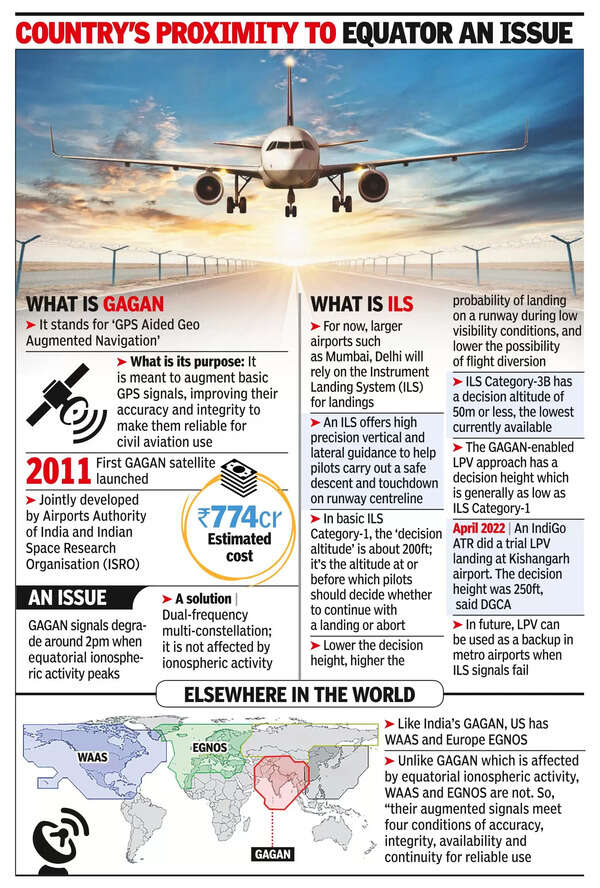- News
- City News
- mumbai News
- Small airports to be 1st to rely on GAGAN satnav for landings
Trending
Small airports to be 1st to rely on GAGAN satnav for landings
IndiGo and Air India ordered 970 Boeing and Airbus planes equipped with receivers for 'augmented satellite signals' for landing. Small Indian airports will use the technology first, with larger airports using it as a backup to ground-based navigation aids.

Beating the ILS installed at big airports is not easy. It offers a high-precision descent angle guidance that also directs aircraft to the runway centreline. Many small airports don’t have ILS though. Here, the pilots use a rudimentary ground-based navigation aid or alternatively, a system of approach and landing that employs satellite signals, the very same signals that help motorists. These signals sent by the global navigation satellite system (GNSS) such as the US’s GPS, for instance, are not accurate or reliable enough for use in, say, low visibility conditions such as winter fog. That is where the augmented satellite signal, the touted game-changer, comes in.

Augmentation makes GPS signals reliable enough for aircraft navigation. Augmentation is done by SBAS or satellite-based augmentation system of geosynchronous satellites that move with the Earth to stay above a certain region, that is.
India’s SBAS, called GAGAN, stands for GPS Aided Geo Augmented Navigation. GAGAN’s job is to take the basic GPS signals and augment them to improve its competency in helping aircraft navigate. While ISRO launched the first GAGAN satellite about 13 years ago, it has been largely jobless all these years. Why? Most aircraft in Indian carriers’ fleet were not installed with the equipment that could receive GAGAN signals. Till now, airlines installed these GAGAN-enabled receivers only on some turboprop aircraft such as ATRs or Bombardiers. Jets largely had GPS-receivers. That has changed now.
An Air India spokesperson said: “All Boeing and Airbus aircraft ordered by Air India will be compliant with GAGAN.”
IndiGo, in a statement, said: “We will start taking deliveries of the 500 aircraft ordered in 2023 by 2030. With LPV being the preference across Europe/ US, we expect all aircraft will be delivered with LPV capability.”
LPV stands for localiser performance with vertical guidance. It is a category of descent and landing procedure that entirely relies on augmented satellite signals such as GAGAN. No ground-based navaids are required. In India, it can be carried out only by aircraft equipped with GAGAN receivers such as the 970 aircraft ordered by IndiGo and Air India. But there is another crucial condition.
LPV approaches can be carried out only if GAGAN signals meet the four conditions of accuracy, integrity, availability and continuity. That is where India’s geographic location poses a problem as it lies close to the equator.
“It is known that equatorial regions pose severe ionospheric challenges that hinder the exploitation of full benefits of GNSS-based flight procedures,” said Narayan Dhital, satellite navigation (GNSS) engineer and air navigation expert at Galileo Control Centre, Germany. A majority of Indian airspace falls under the core equatorial region, so GAGAN’s performance doesn’t meet the four conditions at certain times of the day. “The GAGAN system has to conservatively inflate the ionospheric error protection bound due to a daily phenomenon of larger ion content which peaks around 2pm local time, and of course during high solar activities,” Dhital said. There are solutions though.
“I still see gradual increment in the uptake of GAGAN for flight procedures in the future. This will be largely driven by the dual-frequency multi-constellation (DFMC) GAGAN approach. In such an approach, the above-mentioned critical challenge of the ionosphere is largely eliminated and hence, the confidence in vertical guidance is improved...,” Dhital said. The issue of ionospheric scintillation will remain, he said. “I see a good prospect for GAGAN-based approaches in metro airports after the DFMC system comes into play,” he added.
Making most aircraft GAGAN-compliant is not difficult. “A multi-mode receiver chip costing $20,000 is installed. It’s an easy installation and can be done after aircraft delivery as well,” said an official with an original equipment manufacturer. Airbus and Boeing refused to comment.
End of Article
FOLLOW US ON SOCIAL MEDIA










